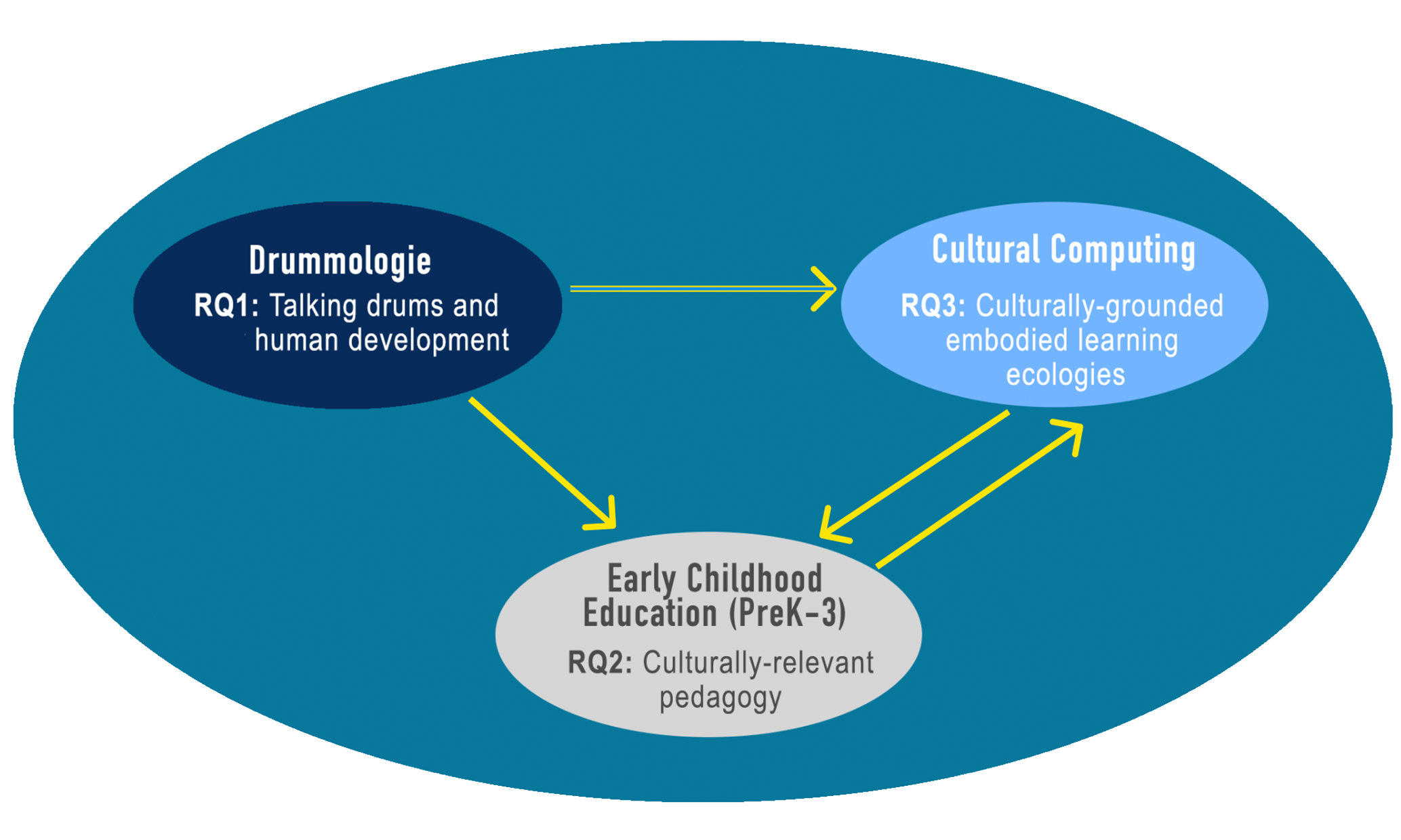Participatory, co-design research is an integral part of UGC's work. While conducting robust studies in Early Childhood Education (ECE) and Music-Based Interventions (MBI) across the lifespan, it is important to understand how the design of the environment and activities impacts children and adults' perception and performance, so that we can continue to center achievement, improve our designs and advance the knowledge base of the field. By engaging in design research, we are able to gain a holistic view of how different elements of the UGC learning organization interact and work together, capture important procedures, formalize the processes, and make visible learning through qualitative and telemetric methods of data collection and analysis. At the same time, we also lift up and celebrate the hard work of custodians of the tradition (griots, drummers, dancers) across the Global African Diaspora (GAD) community by continually increasing our understanding of their tacit knowledge and practice, and by hosting public showcase events. This learner stance enables us as educators, designers and researchers to better serve and preserve the culture by upholding its values and principles. We use mixed methods and draw from a wide range of models, theories and frameworks, while university-community partnerships are integral to how UGC achieves impact. The UGC Advisory Circle also guides the work of the core design team through seasonal convenings, research evaluation and by facilitating connections to various global stakeholder audiences.
UGC research investigates how cultural practices and tools impact the learning ecology and pedagogy through three foci on:
1. Talking Drums, 2. Culturally-Relevant Pedagogy and 3. Culturally-Grounded Embodied Learning Ecologies

Focus 1: Talking Drums
Why talking drums and what areas of learning can African drumming help improve the most?
What is rhythm? Why do humans have rhythm? What is it good for? What are the modalities of rhythm? How has rhythm been harnessed in the cultural context of trans-African societies to mediate social relationships, preserve and transmit knowledge across time and space through embodied practices and tools? How can African cultural systems be leveraged to facilitate learning and well-being from early childhood into the elder years?
While it is commonly acknowledged that children learn best when they are active, the standard approach to early childhood schooling (especially in low-income areas) favors a passive mode of learning focused on the decoding and encoding of print, often overlooking one of the first (and perhaps most important) steps, which is motivation. This dominant cultural and standardized pedagogical design of Western-style schooling, which restricts physical movement and favors learning impassively fails to include as an integral part of the literacy practices those cultural activities, modes and systems responsive to many children who come from backgrounds where voice-, rhythm- and movement-linked activities are the norm.
In order to better understand and thereby support the learning needs of Black and Brown children, we must first understand their cultural context, including their identity, learning styles and the funds of knowledge they bring. This includes their knowledge of music, rhythm, and all that entails.
Focus 2: Culturally-Relevant Pedagogy
How do the culturally-grounded embodied learning activities and tools provided by UGC support children’s development and impact the praxis of parents and teachers?
This is the central focus of our research. We examine how the integration of cultural tools (like talking drums) can contribute to issues of literacy and social-emotional development in PreK-3 setting and fine-tune the design of embodied learning ecologies grounded in the cultural system of talking drum and drum language communication by iterating on the design of multimodal activities that connect learning via rhythm to target skills across the curriculum (literacy, math, science, visual and performing arts), creating a feedback loop. We also investigate how cultural tools help reshape the learning ecosystem in a way that does not further exacerbate existing tensions and dynamics, and ideally work to reverse them, while examining how families (parents/caregivers) may help accelerate children’s learning with increased access, opportunities and support from home.
Focus 3: Culturally-Grounded Embodied Learning Ecologies
How do culturally-grounded embodied learning environments address issues of equity and social justice in computing education?
As we better understand how cultural tools help reshape the learning environment in a way that does not further exacerbate existing tensions and dynamics, and ideally work to reverse them, we also examine how their integration can contribute to issues of literacy and social-emotional development in PreK-3 settings. We investigate and fine-tune the design of learning ecologies grounded in the cultural system of talking drum and drum language communication to iterate on prototypes of more effective embodied and digital activities that connect learning via rhythm to target skills across the curriculum (literacy, math, science, visual and performing arts), creating a feedback loop. We also examine how families (parents/caregivers) may help accelerate children’s learning with increased access, opportunities and support from home.
Synergies and Connections among Three Research Foci
The three research foci complement one another and interact synergistically, to help us understand better how integrating African cultural systems and modalities of rhythm impact students’ learning, and parents'/teachers' praxis. We use the findings from our research in drummologie (Focus 1), relate them with recent advances in human-computer interaction (HCI) to develop culturally-grounded technologies and learning ecologies (Fous 3), and see how these impact children’s learning experiences, and how the continuous engagement of parents, cultural experts, teachers’ and educational leaders’ (Focus 2) could help drive the change. In this way, the new digital tools we develop based on African talking drums bridge the home, school and community contexts, and further supports our leadership work in leveraging culture and computing to transform the ecology of early childhood. Our research work advances through a positive feedback loop, adding new knowledge with each cycle of intervention, iterating on design prototypes and providing high quality, culturally-relevant curriculum for parents and professional learning for future teachers and leaders.

